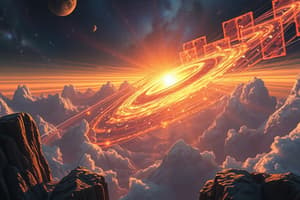Podcast
Questions and Answers
Match the following cell types with their functions:
Match the following cell types with their functions:
Nerve cells = Carry messages Muscle cells = Get bigger and stronger with exercise Blood cells = Signal when something needs fixing Bone cells = Build new bone tissue
Match the following statements with their correct explanation:
Match the following statements with their correct explanation:
Sperm and eggs are involved in reproduction = They are male and female reproductive cells Ovaries contain eggs = Special bags where eggs are located in female bodies Eggs are made ready by glands near the stomach wall = Glands prepare eggs for fertilization One egg is needed to make a human being = Each individual is formed from a single egg
Match the following statements with their correct process:
Match the following statements with their correct process:
Sperm swim towards eggs = To fertilize the egg for reproduction A man transferring sperm into a woman's vagina = Introduction of male reproductive cells into female body Swimmers reaching an egg first = Fertilization process begins Egg and sperm joining together to form a baby = Start of embryonic development
Match the following forces with their descriptions:
Match the following forces with their descriptions:
Match the following laws of motion with their descriptions:
Match the following laws of motion with their descriptions:
Match the following cell components with their functions:
Match the following cell components with their functions:
Match the following terms related to sex with their definitions:
Match the following terms related to sex with their definitions:
Flashcards are hidden until you start studying
Study Notes
Science: Force, Motion, Cell Biology, and Sex
Science is a vast field encompassing many different disciplines, each providing insights into our world and how it works. Here we'll explore four key areas within science: force and laws of motion, cell biology, and sex. Each of these fields expands our understanding of life around us.
Force and Laws of Motion
Force is the push or pull between two objects. It can cause things to move, stop moving, bend, or break. Isaac Newton discovered three fundamental laws of motion in his work with gravity. These laws describe what happens when something changes direction, either speeding up, slowing down, turning left or right; they also explain why things fall from tall buildings without flying away. When you drop your book, the air pushes against it until you catch it. That's called friction—it helps keep everything close together where it belongs! But if there were no friction, things would fly apart very quickly after being dropped.
Cell Biology
A cell is the smallest unit of living matter that makes up all plants, animals, fungi, algae, protozoa, bacteria, and some viruses. A single cell contains thousands of tiny molecules called proteins, which help make big structures like muscles or bones. Cells take food, water, oxygen, vitamins, minerals, hormones, and waste out from inside them through their skin. They grow by taking new materials from outside themselves and using them to make more cells just like themselves. Cells are always changing shape because they have parts that change shape too —these are called organelles.
There are several types of cells, including nerve cells, muscle cells, blood cells, and bone cells. Nerve cells carry messages so fast that they don’t need any extra energy for doing this work. Muscle cells get bigger and stronger when you exercise and smaller again when you rest. Blood cells let other tissues know if something needs fixing, such as cutting yourself or getting sick. Bone cells build new bone tissue where old bone has been removed due to injury or disease.
Sex
When men and women reproduce, they make a baby together. This process involves both sperm (male reproductive cells) and eggs (female reproductive cells), plus lots of chemicals inside the body. Sperm swim towards eggs, which live in special bags called ovaries in female bodies. Eggs are made ready by special glands near the stomach wall. One egg is needed to make one normal human being. So when a man puts his penis into a woman's vagina, he transfers millions upon millions of little swimming men into her body. If one of these swimmers gets to an egg before another does, they meet, join together, and start growing into a baby.
These are just a few examples of how scientific study sheds light on forces shaping our environment, the building blocks of life, and the processes of reproduction. There's much more to discover as scientists continue their quest to understand and improve our lives.
Studying That Suits You
Use AI to generate personalized quizzes and flashcards to suit your learning preferences.




